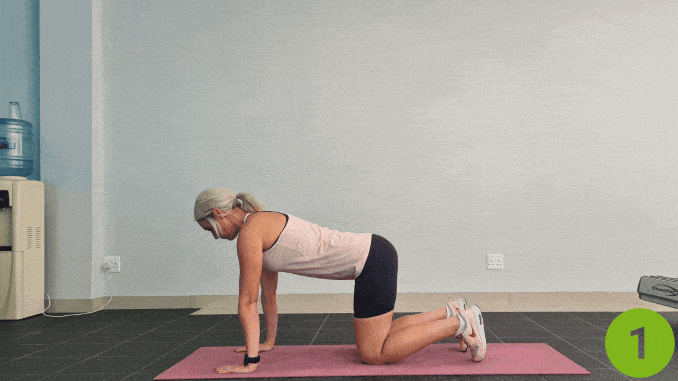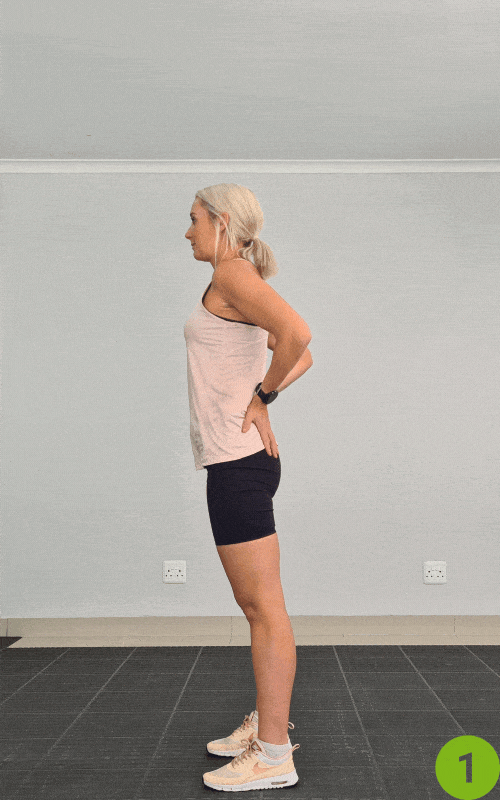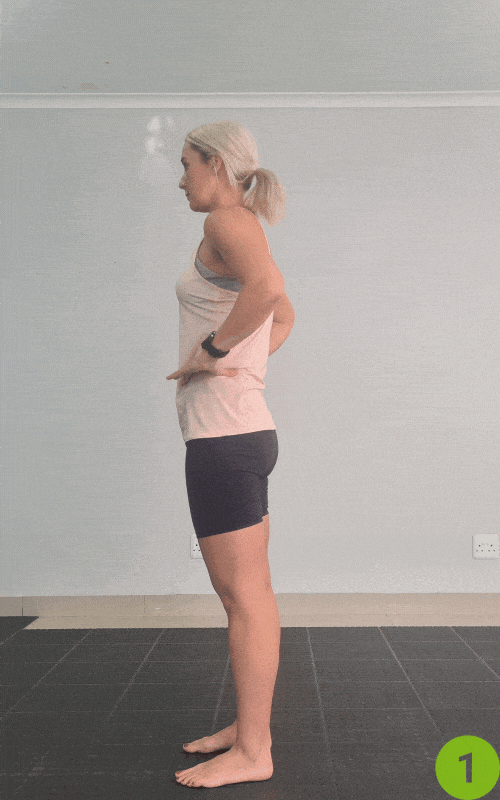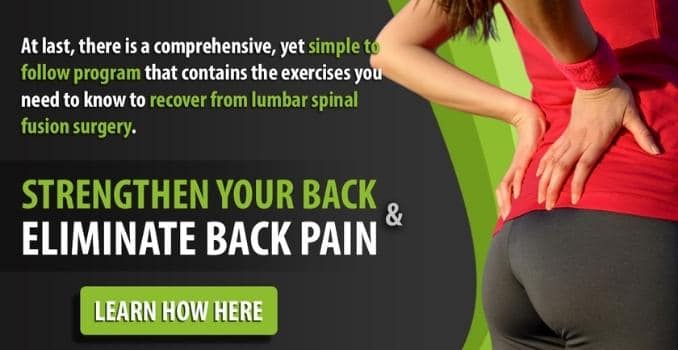
Working with a client who has a herniated disc? Every move counts — focus on safe exercises for herniated disc to protect and then support their recovery.
One wrong stretch or load can aggravate nerves, trigger leg weakness, affect bowel or bladder control [2], or cause chronic back pain.
But with the right exercise program, you can relieve pressure, rebuild strength, and even accelerate herniated disc recovery—safely.
Furthermore, let’s dive into how you can use safe exercises for herniated disc clients to promote healing—not harm.
Tips to Clients with a Herniated Disc
1. Communicate with the Team
Make sure she is cleared to start an exercise program by her healthcare team, and if the team has any recommendations on what she should do or not do.
2. Find out what Positions Her Back Likes
Often, clients will say that lying down is the best, followed by standing and sitting.
This is all based on the level of load on the spine.
Furthermore, lying down there is the least spinal load, making it a preferred position for clients with severe discomfort.
With lying, there is the least amount of gear. With standing, your legs act like shock absorbers and take up a fair bit of load. And with sitting, the load moves into the spine more.
Even if she likes lying down the best, there is a lot you can do with bands and pulleys to strengthen her back in that position.
3. Leg Strength
Work on leg strength. If you can improve her legs, then her leg muscles will take on more load, and less will be put onto the spine when she stands.
You may have to start with a ball squat, which keeps the back upright.
This may not be a natural or functional position, but it puts the least amount of stress on the spine. In time, you progress her to more of a normal squat movement.
4. Limit Trunk Flexion
The movement that involves trunk flexion will increase the load on the back.
At the start, avoid it. But with time, you want to train different ranges of motion.
Start with a ball squat, progress to a front ball squat, then to a standing squat.
5. Core Activation
I would work on a rehab level of core stability.
Pain often leads to the inhibition of the deep stabilizing muscles of the spine. It’s essential to reactivate them.
According to Dr. Todd H. Lanman, a renowned spinal neurosurgeon based in Beverly Hills, California, specializing in spinal health and herniated disc treatments.md “Exercise can strengthen the muscles supporting the spine, improve flexibility, increase blood flow to the affected area, and reduce pressure on the herniated disc. These benefits not only contribute to pain relief but also aid in preventing future injuries and improving overall quality of life.”
Step-By-Step: 3 Go-To Safe Exercises for Herniated Disc Relief
Start only after clearance from a healthcare professional.
Then, progress gently with these core movements designed to restore function without risking further injury.
1. Bird Dog

Targets: Core, deep spinal stabilizers, and then upper body musculature.
- Begin in a 4-point position, with your hands underneath your shoulders and then your knees underneath your hips.
- After that, contract your abdominal area.
- Take a deep breath and lift one arm to align with your shoulder as you extend your opposite leg behind your body.
- Keep your hips and then shoulders parallel to the floor.
- Hold the position for several deep belly breaths, in through your nose and out through your mouth.
- 10 reps per side, done in a slow and controlled manner.
Promotes spinal alignment, activates deep stabilizers, and improves posture.
2. Standing Extension (Backward Bend Exercise)

Targets: Lumbar spine, posture, spinal decompression.
- Begin in an upright standing position with your feet hip-width apart, maintaining good alignment with your head, shoulders, hips, and legs.
- Place your hands at the back of your hips.
- Engage your core muscles.
- After that, slowly bend your upper body backwards.
- After that, hold 3–5 seconds, return to center.
- Do 5–10 times.
Reduces disc pressure, great for lumbar disc herniation.
3. Pelvic Tilts

Targets: Core, hips, lower back.
- Begin in an upright standing position with your feet shoulder-width apart, maintaining a neutral alignment through the spine with your head, shoulders, and hips stacked.
- After that, place your hands on your hips.
- Engage your core and gently tilt your pelvis back to flatten your lower back against the floor (if lying) or maintain stability (if standing).
- Hold this position for several deep belly breaths, in through your nose and out through your mouth.
- Relax and then return to the starting position.
- Repeat 10–15 times.
Builds abdominal control, helps with hip arthritis, boosts stability.
How to Tell If You’re Exercising at the Right Level
- Use this checklist woth your client.
- No sharp or lingering herniated disc pain
- No tingling, leg pain, or neck pain
- Movements feel steady, not forced
- Breathing stays even throughout
If symptoms worsen or they feel unstable, STOP. You’re doing too much.
How Many and How Often?
- Start with 2–3 sessions per week, ensuring at least one day of rest between sessions to allow for recovery
- 8–15 reps per set
- Begin with 1–2 sets and then progress gradually
- Focus on controlled, gentle movements to avoid fatigue and then ensure safe execution
Bonus: Two Yoga Poses That Help Relieve Pain
- Child’s Pose – Encourages spinal elongation and then relaxation of the surrounding musculature.
- Cat-Cow – Mobilizes the spine and then warms up the core
These are ideal to include in a tailored exercise program for chronic or aging clients.
When to Refer Out to a Physical Therapist
- If your client shows:
- Worsening herniated disc symptoms
- Sudden changes in bladder control
- Severe spinal nerve pain or leg weakness [1]
- They may need to pause their program and then work with a physical therapist or specialist immediately.
Final Thoughts: Be the Trainer Who Heals, Not Hurts
- With the right approach, you can:
- Strengthen muscles safely
- Protect the cervical spine and lumbar spine
- Improve cardiovascular health with low-impact movement
- Help them reclaim control of their body
Stick to safe exercises for a herniated disc [4], build slowly, and then always assess pain signals.
You’re not just training their body—you’re guiding them back to function.
Conclusion
Working with clients recovering from a herniated disc means more than teaching movement—it’s about restoring confidence, easing fear, and promoting healing through safe, effective exercise.
When you focus on gentle stretches, proper core activation, and strategic progressions, you’re giving your clients the tools to relieve pain, improve posture, and reclaim control of their bodies—without risking further injury.
Furthermore, every client is different. What matters most is paying attention to how their body responds, adjusting when needed, and building a program that supports their unique recovery journey.
Whether you’re helping them avoid chronic pain [3], strengthen their abdominal muscles, or regain spinal alignment, remember this.
You’re not just helping them move again—you’re helping them believe in their body again.
In addition, stay consistent. Stay compassionate.
And always keep safety at the center of your program design.
Start Your Recovery Today! Download our Lumbar Spinal Fusion Recovery Program and then get expert-guided exercises, pain management tips, and daily progress tools. Regain strength and confidence—right from home. Click below to begin your healing journey now!
FAQs
What are the safest exercises for a herniated disc?
The safest exercises include low-impact movements like bird dog, pelvic tilts, standing extensions, and then gentle yoga poses like child’s pose. These exercises reduce spinal pressure, activate support muscles, and can help relieve pain without straining the lumbar spine.
Can I make a herniated disc worse by exercising?
Yes—if you do the wrong movements. Avoid exercises that involve deep trunk flexion, twisting under load, or heavy lifting, especially early in recovery. Always monitor for more pain, leg weakness, or numbness, and adjust the program accordingly. Start slowly and then progress under guidance.
How often should I do exercises for a herniated disc?
Begin with 2–3 sessions per week. Start with 1–2 sets of 8–15 reps per exercise, and then increase only as tolerated. Consistency with gentle exercises is more important than intensity. Overdoing it can cause further injury and set back recovery.

